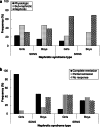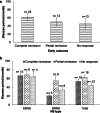Efficacy of rituximab therapy in children with nephrotic syndrome: a 10-year experience from an Iranian pediatric hospital
- PMID: 35022016
- PMCID: PMC8753871
- DOI: 10.1186/s12887-022-03109-4
Efficacy of rituximab therapy in children with nephrotic syndrome: a 10-year experience from an Iranian pediatric hospital
Abstract
Background: There are controversy results in the optimal management of children with steroid-dependent and steroid-resistant nephrotic syndrome (SDNS, SRNS). This study aimed to determine the efficacy and safety of rituximab (RTX) in these pediatric patients.
Methods: Medical records of 1-18-year-old Iranian children with SDNS (n = 26) and SRNS (n = 22) with a follow-up for at least 24 months were included from 2009 to 2019. The short- and long-term responses to RTX were respectively evaluated to determine the random protein-to-creatinine ratio after 6 and 24 months and classified as complete (CR) and partial (PR) remission or no response.
Results: Male patients (n = 26) were slightly predominate. The median age of patients at the time of RTX therapy was 8.6 ± 4.01 years. At the end of the 6-month follow-up, CR and PR occurred in 23 (47.9%) and 12 (25%) patients, respectively. Of 23 patients with CR, 18 (69.2%) and 5(22.7%) had SDNS and SRNS, respectively (p < 0.005). However, only 18 (37.5%) of patients after 24 months had been in CR. No significant difference in the CR rate was found between the two groups. RTX was more effective when administered during the proteinuria-free period (p = 0.001).
Conclusion: In the short term, RTX significantly was efficient in inducing complete or PR in SDNS and SRNS patients. However, the favorable response rate in a long-term follow-up was insignificantly lower between the two groups.
Keywords: Nephrotic syndrome; Pediatrics; Rituximab; Steroid dependent nephrotic syndrome; Steroid resistant nephrotic syndrome.
© 2022. The Author(s).
Conflict of interest statement
The authors declare that they have no conflict of interests.
Figures
Similar articles
-
Study protocol: mycophenolate mofetil as maintenance therapy after rituximab treatment for childhood-onset, complicated, frequently-relapsing nephrotic syndrome or steroid-dependent nephrotic syndrome: a multicenter double-blind, randomized, placebo-controlled trial (JSKDC07).BMC Nephrol. 2018 Nov 1;19(1):302. doi: 10.1186/s12882-018-1099-7. BMC Nephrol. 2018. PMID: 30382824 Free PMC article. Clinical Trial.
-
Risk factors for relapse and long-term outcome in steroid-dependent nephrotic syndrome treated with rituximab.Pediatr Nephrol. 2016 Jan;31(1):89-95. doi: 10.1007/s00467-015-3197-0. Epub 2015 Sep 4. Pediatr Nephrol. 2016. PMID: 26341251
-
Rituximab Administration to Treat Nephrotic Syndrome in Children: 2-Year Follow-Up.Biomedicines. 2024 Nov 13;12(11):2600. doi: 10.3390/biomedicines12112600. Biomedicines. 2024. PMID: 39595166 Free PMC article.
-
Rituximab in children with steroid-dependent nephrotic syndrome: experience of a tertiary center and review of the literature.Acta Clin Belg. 2017 Jun;72(3):147-155. doi: 10.1080/17843286.2016.1208955. Epub 2016 Jul 13. Acta Clin Belg. 2017. PMID: 27409338 Review.
-
Rituximab for nephrotic syndrome in children.Clin Exp Nephrol. 2017 Apr;21(2):193-202. doi: 10.1007/s10157-016-1313-5. Epub 2016 Jul 15. Clin Exp Nephrol. 2017. PMID: 27422620 Free PMC article. Review.
Cited by
-
Clinical practice guidelines for rituximab treatment in children with steroid-sensitive nephrotic syndrome.World J Pediatr. 2025 Aug 13. doi: 10.1007/s12519-025-00957-9. Online ahead of print. World J Pediatr. 2025. PMID: 40802032 Review.
-
Forging the Future: B Cell Activating Factor's Impact on Nephrotic Syndrome.Malays J Med Sci. 2024 Dec;31(6):57-64. doi: 10.21315/mjms2024.31.6.5. Epub 2024 Dec 31. Malays J Med Sci. 2024. PMID: 39830109 Free PMC article. Review.
-
Characteristics Scanning of Brain Structure and Function Changes in Patients with Different Degrees of Alzheimer's Disease.Contrast Media Mol Imaging. 2022 Sep 30;2022:5238941. doi: 10.1155/2022/5238941. eCollection 2022. Contrast Media Mol Imaging. 2022. Retraction in: Contrast Media Mol Imaging. 2023 Dec 13;2023:9830349. doi: 10.1155/2023/9830349. PMID: 36262986 Free PMC article. Retracted.
-
Long Term Evaluations of First Single-dose Rituximab in Children with Steroid-Dependent Minimal-Change Nephrotic Syndrome.Ren Fail. 2024 Dec;46(2):2427173. doi: 10.1080/0886022X.2024.2427173. Epub 2024 Nov 26. Ren Fail. 2024. PMID: 39593209 Free PMC article.
References
-
- Niaudet P, Boyer O. Idiopathic nephrotic syndrome in children: clinical aspects. In: Avner ED, Harmon WE, Niaudet P, Yoshikawa N, Emma F, Goldstein SL, editors. Pediatric nephrology. 7. Berlin: Springer; 2016.
MeSH terms
Substances
LinkOut - more resources
Full Text Sources
Research Materials



